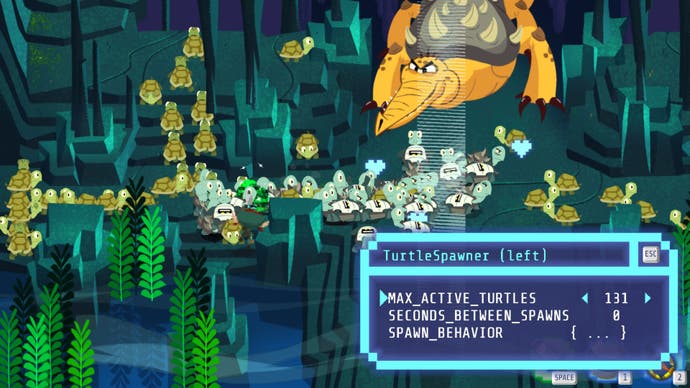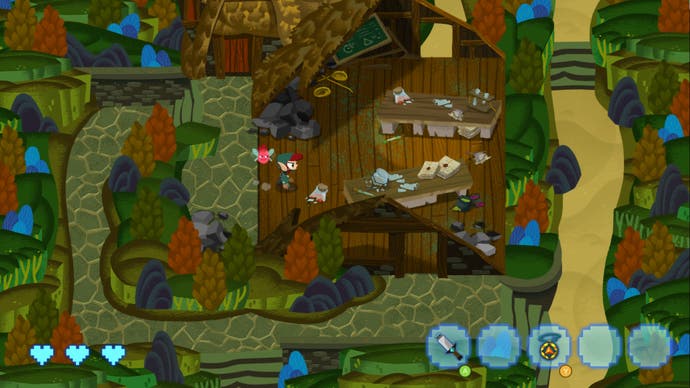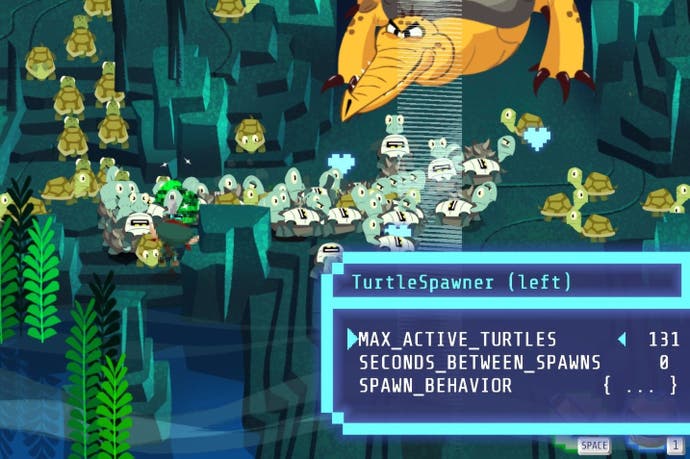Hack 'n' Slash review
No substrings attached.
The latest experiment to pop out of Double Fine is built around a pun so brilliant and so obvious, you wonder why nobody has done it before.
On the surface, Hack 'n' Slash is a charmingly illustrated Zelda clone, a top-down adventure in which you explore a flip-screen fantasy kingdom in a quest to defeat an evil wizard. The twist comes from that seemingly generic title: this is a game where you literally hack things with your sword. That's hack as in "computer hacking". Mere moments after receiving your weapon, while locked in a dank dungeon, you clang it against the cell door only for it to break, revealing a USB-style protrusion. It's the almost endless possibilities opened up by this discovery that provides your chance to survive and thrive, not your ability to slice things up.
So you try the sword on the door a second time, and now you can access the code dictating the door's behaviour.
GateDoor
OPEN false
So you switch it to "true" and the door swings open. That's pretty much all the hacking tutorial you get, as the game uses the context that the adventure game framework provides to make you understand the code instinctively. The next thing you come across is a rock - again marked by a USB port that shows it can be hacked. The rock is blocking your path, and you can alter variables such as how many times it can be pushed, how far it will move with each push, and even how long you need to push to make it move.

Even at this early stage, barely minutes into the game, already you can see what an incredibly powerful tool you have. The game doesn't place any limits on how much you can change. You can tweak the code the bare minimum needed to push the rock one space out of your way, allowing you to proceed, or you can experiment and make it fly right across the screen with a gentle tap.
As you venture out into the world, filled with toxic swamps, gloomy forests and a foreboding castle, the game keeps offering opportunities to try out your hacking skills. True to the Zelda formula, you can hack bushes, but here you get to decide how many health-restoring hearts they'll provide, before setting them on fire - again, through a Boolean code toggle - to reap your reward.
Enemies are even more fun, offering a giddy array of hackable attributes. You can reduce the radius of their perception, essentially making them blind. You can reduce their damage, so they're incapable of harm. You can switch them from bad to good, so they'll ignore or even defend you rather than attack.
What's even more impressive is that this isn't some surface-level simulation of hacking. In Hack 'n' Slash you really are seeing the game's code, and you really are changing it on the fly. Even if you don't know C++ from Javascript, you can't help but learn how code works. For anyone who grew up on BASIC-powered home computers, breaking into the program with a button press and changing the team names in Kevin Toms' Football Manager to Boobs United, it's both wonderfully nostalgic and refreshingly forward-thinking.

It's a gameplay mechanic that should, in theory, completely ruin the balance of the game, but each scene and encounter is constructed in such a way that you never become an unstoppable god. By limiting the objects you can hack and the state they must be in to be hacked, the game makes you work for those moments of power, but never holds you back from revelling in it when the time comes.
If you want to set a turtle-spawning nest to spew out 100 turtles in two seconds, you can. And you will break the game in doing so. Or you may move a block and leave yourself trapped. That's why one of the early items you collect allows you to rewind to the start of each new area you enter, allowing you to undo any bugs you've inadvertently - or completely deliberately - left behind. It very quickly becomes clear that the title is almost entirely ironic. Hack 'n' Slash is not a hack 'n' slash game. You will engage in almost no direct combat, and instead the game reveals itself as an intricate puzzle adventure, where your freedom to tinker results in multiple paths to success.
That freedom does sometimes act against the game's best interests though. Remove the hacking element and the game underneath is a very old-fashioned thing indeed, a truly hardcore thing with precious little guidance and a lot of backtracking across familiar screens as you look for the way ahead. There's even one of those infuriating maze areas, made up of endlessly spawning pathways that never lead anywhere.
Progress is made up of head-scratching roadblocks, followed by the brief elation of a solution discovered, then the pleasure of exploring a new location, before coming up against another roadblock. It's a pattern that will be familiar to hardened veterans of the 1980s, but such circular frustrations can be off-putting in 2014.

Those frustrations are sweetened considerably by the delightful visuals, which manage to balance fairytale whimsy with a stylised indie aesthetic and a smart script that walks a similar line between earnest fantasy and glib tongue-in-cheek quips. It is, in other words, unmistakably a Double Fine game.
The game has only just emerged from Early Access, and there are still a few rough edges to shave off. Navigating around objects can be a bit of a scruffy fiddle, as the perspective coupled with a strict grid-based layout means that sometimes you'll find yourself unable to pass through spaces that are clearly large enough, or else get snagged on invisible corners of objects. Hit detection, too, is lacking in finesse and there's very little character feedback to let you know when you're taking damage. Neither problem hurts Hack 'n' Slash's appeal too much, but they do conspire to make it feel a little less polished than its gorgeous graphics suggest.
Sometimes, the obstacles feel unfair. An early example is the ravens that bombard you in the opening area of the game. They don't bear the signature USB port that tells you something can be hacked, yet when you hit them with your sword you can hack them all the same. When one of those ravens is obscuring the path ahead and must be hacked, yet the game's own established visual cues are telling you it can't be, it's an annoying - albeit rare - moment where you feel the game is being needlessly obtuse.

Those minor bumps in the road aside, Hack 'n' Slash is something of a perfect storm of indie game design. It takes a simple yet brilliant idea and executes it as thoroughly and thrillingly as you could ever want. It openly acknowledges its debt to the past, but never to the point where it is held back by nostalgic dogma. The things that will make you smile far outnumber the things that make you frown.
More than anything, it demands your attention and teaches you about coding in the most natural way possible. There have been many games that attempt to "teach coding" by forcing you to program in-game robots or similar, but Hack 'n' Slash is far more organic than that. As the puzzles become more complex, you'll find yourself poring over lines of code looking for the variable that is causing the problem, looking for a creative way to bend the rules to your will, and you realise that to all intents and purposes, at that point, you are a coder.
If that sounds too much like hard work then you may be right and Hack 'n' Slash won't be the game for you. If the concept behind it elicits even the slightest flicker of interest, however, you should definitely give it a try. You may even learn something.

